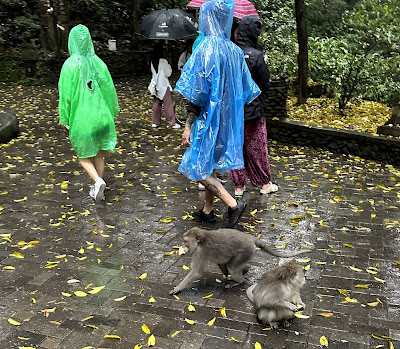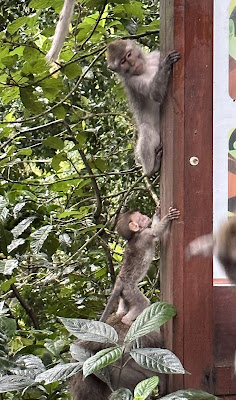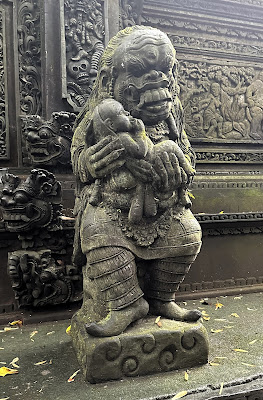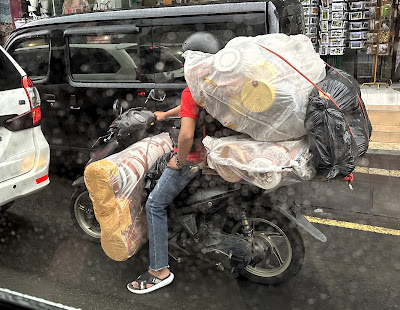July 13, 2023
After lunch we headed to the Monkey Forest in the town of Ubud. (Ubud is the cultural heart of Bali and is probably where we should have stayed.) The full name of the place is The Sacred Forest Monkey Sanctuary.
The entrance has a couple of inviting statues.
Next to the lobby is a lake with a few more interesting sculptures, this one of a Komodo dragon and its youngster drinking from the water (and apparently about to chomp on those koi).
Another shows three piglets and their wild boar parent.
The park is filled with interesting, moss-covered statuary. One of my favorites was this one that looks like an old man head on a slug body being tormented by three monkeys.
Of course, one would expect to see the popular monkey triumvirate: Speak No Evil, See No Evil, Hear No Evil.
A petrified watering hole:
I'm not sure what kind of creature is lurking over this tunnel entrance, but he is kinda cute.
The stone creatures are fun, but most people come here to see living things. The Monkey Forest has approximately 1300 resident Balinese long-tailed macaques that are considered sacred by the local Balinese people. This forested area has been considered a sacred place since at least the 14th century, and in the 20th century it became a conservation area (as well as a tourist site). The monkeys sleep at night and are out in abundance during the day.
The monkeys are fed at least nine times a day, according to the park's website. Their primary diet is sweet potatoes, but they also get bananas, papaya leaves, corn, cucumbers, coconut, and other local fruit.
Visitors are not supposed to feed the monkeys, but some do anyway, including our guide, who threw what looked like an Oreo cookie at one. Does a Balinese long-tailed macaque know the proper way to eat an Oreo?

Why yes, yes it does.
Later, maybe the same monkey or maybe another that could smell cookies in our guide's pack crawled up her leg to the pack on her chest. She screamed and had to push it several times before it jumped away. I guess that's why you aren't supposed to bring food into the park!
There was one man who looked like a park employee who was hand-feeding one of the monkeys. You can also watch of video
here.
The monkeys are friendlier and less aggressive here than the ones we had seen at Uluwatu Temple three days earlier.
That is probably because everywhere we looked there were piles of food they were gorging themselves on.
Different family groups inhabit different areas of the park. I didn't know that monkeys are territorial! Invading another group's territory leads to loud and sometimes violent altercations. However, the monkeys don't seem to mind the crowd of human invaders--10,000 to 15,000 a month.
They don't mind the rain either.
Besides the macaques, the park is known as an ecological preserve that covers about 31 acres and has 186 species of plants and trees. There are a few trees that supposedly date back to the 14th century, which is when the temple complexes were built in this forest.
Can you see the monkeys in the tree in the photo on the left? I will zoom in. There they are!
The design and landscaping of the forest-park is almost Disneyland-ish with its wandering sidewalks, many bridges over a stream far below, multiple levels, heavy forest, and seemingly ancient statuary.
And of course, there were plenty of good photo spots, even in the rain.
But the monkeys definitely own the place. It all seems to revolve around them. We saw lots of mamas with babies, lots of grannies and gramps, and lots of mustached monkeys.
We especially loved the mamas with babies. Macaques have a six-month gestation period and generally keep their babies close (VERY close) for about ten months before weaning them.
Here are two mamas comparing their babies.
They are so cute! And look at that humanoid hand.
This looks like a nursing mama, but where is her baby? The babies that aren't being clutched by the mamas are staying pretty close anyway.
While we could not enter the temples, there were no spaces the monkeys were barred from entering and no statues they could not climb.

The Pura Beji Padangtegal (or Holy Spring Temple) is one of the three main temples in the park and is dedicated to the worship of The Goddess of Gangga. According to information at the site, worship here "aims to convey gratitude for the blessing of holiness and prosperous life." Those who pray here must wear traditional Balinese "prayer dress." No western attire is allowed.
The temple has a sign warning tourists not to enter.
It doesn't say anything about monkeys, however.
The monkeys were already here when this forest was designated as a holy place for Hindus, and our guide said the temples were built to protect the monkeys from evil spirits. As noted above, the temples are used occasionally for public ceremonies.
The next one we saw was Pura Damlem Agung Padangtegal, aka The Great Temple of Death or the "main temple." This temple, according to Wikipedia, is used for worshiping the god Hyang Widhi in personification of Shiva. Like the other two temples, it is thought to have been built around 1350.
The third temple is the Cremation Temple. According to the sign, bodies are buried temporarily in an adjacent plot until a mass cremation ceremony, which occurs every five years.
The monkeys were a lot of fun, and the temples (or what we could see of them) were beautiful, but I think what I liked most at the Monkey Forest was the statuary. So many fun pieces!
The one below right of the ogre-ish looking creature holding a human baby? Terrifying.
After a couple of hours, we left for our final destination, the Tanah Lot Temple, about 22 miles away. An ancient Hindu pilgrimage site, it consists of a 16th-century temple built on a rock formation that can be accessed at low tide (much like Mont St. Michel in France) and is one of seven "sea temples" around the Balinese coast.
Tour guides and their drivers should be able to anticipate driving time, right? Ours failed miserably.
We left the monkey forest at 4:00. It took us almost an hour just to make it through a few blocks of heavy congestion in the Ubud tourist area.
You can tell how slow we were driving by watching the shops we drive by. The only vehicles making much progress were the motorcycles, and there were plenty of them.
When we finally got out of town, it took us another hour-and-a-half of driving through small towns and backstreets to make it to our destination. TWO-AND-A-HALF HOURS TO GO 22 MILES. I wonder now if the driver got lost. We wouldn't know as neither he nor our guide really spoke to us during this time. It even crossed my mind that we were being kidnapped.
 |
Our driver's interesting ring
|
Of course, after two-and-a-half hours, we needed to go to the bathroom, so as soon as we arrived we found a restroom. When we came out, it was completely dark, and the only thing we could see was this illuminated sign.
We walked to the view area from which we should have been able to see the Tanah Lot Temple, but all we could see was an indistinct form out in the water and an occasional white cap on the waves. The tide had rolled in long ago and blocked access to the temple.
Here's a picture from the internet of what me missed.
It was unbelievable to us that our guide and driver thought this trip was a good idea. It took almost two hours to get from Tanah Lot back to our hotel, so we spent 4.5 hours in the car to take a photo of a sign, the only thing we could actually see. To add insult to injury, this was one of only two afternoons we had in Bali. Surely there was something closer to Ubud and the Monkey Forest. Even being dropped off to enjoy the tourist shopping area for a few hours would have been preferable to this total fail.
For some reason we had been upgraded at our hotel to a mini-suite (compensation for the failed trip to Tanah Lot Temple?), a three-room grouping of a bedroom, bathroom, and living room with two TVs, a balcony, and an extraordinary number of plugs for charging our electronics. We'd never had as many anywhere else.
Two views of our huge bedroom:
The night stand drawer held a Bible, a Buddhist (or Hindu?) text, and the Koran.
In the morning we enjoyed an enormous breakfast buffet with about eight different sections. I wish I had taken some pictures of the food. Instead, I did get a photo of this interesting combo of a hijab and a baseball cap.
In the lobby, a woman was weaving table runners and wraps. I bought one and she let me take a few photos.
The very fancy lobby:
Next: Our journey home
















































































